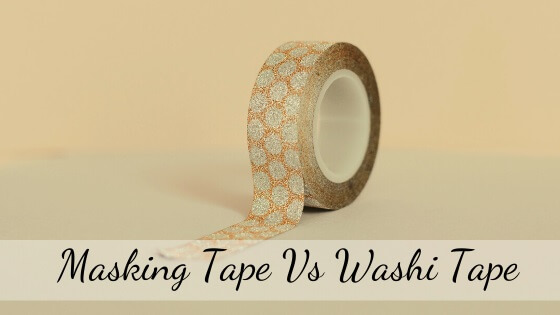When deciding on the right tape for the job, you probably heard the name washi tape crop up often!
So, what exactly is washi tape?
The whole washi tape phenomenon was conceived around 2006, when a group of artists requested a Japanese masking tape manufacturer to produce colorful masking tapes for artists.
Now you may be wondering if washi tape is the same as masking tape, and if not, how do the two differ from each other?
Short answer is that even though the two types of tapes are considerably similar in design and functionality, there are a few noteworthy differences that set the two apart.
Can I Use Washi Tape as Masking Tape?
Yes, you can use washi tape as masking tape, because both contain the same durable adhesive and tear easily, but the latter may not provide the same aesthetic appeal.
Masking tape is used for a wide range of applications including painting and carpentry work to basically hold things together, or protect the surface of an object from fresh paint.
Adding to this, masking tape comes in only a handful of colors such as red, yellow and fuchsia.
Contrarily, washi tape can be considered as artistic tape, making it a great choice for scrapbooking, and is just a more vibrant option when sticking down pieces.
So even though both types of tape are highly durable, you can’t really use masking tape to tape down your gift-wrapping paper.
Sometimes dubbed as deco tape, washi tape is also easy to peel off easily without causing damage to the surface, and can also be reused, giving you more bang for your buck.
What is the Difference Between Masking Tape and Washi Tape?
Washi tape stems from masking tape, yet there are myriad key differences between the two types including:
Material
The word washi is a combination of two words —wa meaning Japanese and shi meaning paper, so if you haven’t guessed yet, washi tape is made from traditional Japanese washi paper.
This paper is processed by hand, and is made in a traditional way using local fiber.
The fibers used in the production of washi paper come from several different trees or shrubs such as paper mulberry (kōzo) bush, mitsumata shrub (Edgeworthia chrysantha), inner bark of the gampi tree.
Washi tape material is also claimed to tougher than paper made from wood pulp, which is probably why it is a preferred choice for several traditional arts including Origami, Shodo, and Ukiyo-e.
Often referred to as painter’s tape, masking tape is made from thin paper, making it easy to tear by hand.
There are however a few high-quality masking tapes that are made from polymer film rather than paper, but this range of tapes is a bit more expensive.
Adhesive
Washi tape features a low tack adhesive, which is pressure sensitive adhesive that can be used to reposition or reuse the tape anywhere, and can easily be removed without causing damage to the surface.
Masking tapes can use one of two different types of adhesives — acrylic and rubber.
Acrylic can be solvent or water based, and offer great UV resistance, durability, solvent resistance and temperature resistance.
Rubber adhesives can be made from synthetic or natural rubber, and in most cases are medium to high tack.
Use on paper
Masking tape features a much stronger adhesive than washi tape, hence may tear the paper when removed.
Washi tape feature a low tack adhesive, so will come off easily from most papers, but not tissue papers.
Residue
Washi tape is easily removable, and does not leave any residue or cause damage to the surface, which is why it is great choice for rental or other similar spaces.
Masking tapes can leave a sticky residue, especially when left on for too long, and can chip off paint and other finishes.
Longevity
Washi tape can last a year or more when applied to a wall.
Most masking tapes have a shelf life of one year, and designed to adhere to surfaces for longer up to 60 days depending on the surface.
Surface compatibility
Masking tape is a go-to choice for a wide choice for several DIY applications, and sticks well to a variety of different even and irregular surfaces.
However, on the downside, the paper portion of the masking tape may come off with age when used on certain surfaces such as glass.
Washi tape can be used on almost all surfaces, without leaving any residue, thanks to its natural fiber construction.
Biodegradable
The paper part of masking tape is 100 percent biodegradable, whereas the adhesive portion in most cases is not completely biodegradable.
Washi tape is made out of highly renewable resources including the adhesive, making it 100 percent biodegradable.
Conclusion
Washi tape is made from special Japanese washi paper, and is thin enough, so can be torn easily by hand.
Adding to this, it is easy to peel, and reposition, without leaving any residue.
Washi tape is also available in a plethora of different patterns, colors, pictures and textures, and can be used on all types of surfaces including dusty, oily, wooden and rough surfaces.
Masking tape features a much stronger adhesive than washi tape, making it an ideal choice for applications such as painting or to label food and school supplies.
Masking tape is not completely biodegradable, and is only available in a limited number of colors, so is not a good fit where aesthetic appeal is needed.
Adding to this, washi tape is kid-friendly, and can be used for home décor, arts and crafts to school related projects.
Both washi and masking tapes are waterproof and heatproof, so regardless of which type you use, you can be rest assured of superior durability.
Speaking of which, when applied to the surface, washi tape tends to last longer, upwards of a year or so.
Masking tape has a roughly a shelf life, and generally lasts for 60 days or so when applied to most types of surfaces.
Related Articles:



